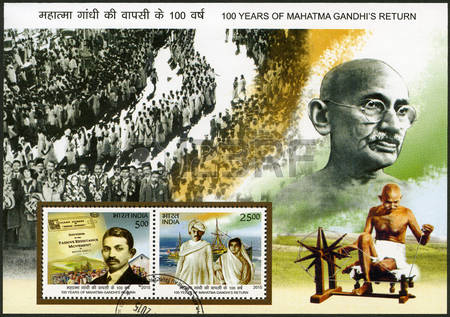Non-violence and the Indian Crisis

Gandhi poster commemorating his 1915 return to Indian from South Africa, courtesy www.123rf.com
Editor’s Preface: This is the last in our series of articles from the IISG/War Resisters’ International archive; it was first published in the May 3, 1946 issue of Peace News. We have selected this particular article because of Gandhi’s criticism of destruction of property, a tactic used by the Vietnam War protest movement, as with the burning of draft files. The discussion was later revisited by Occupy, and especially Occupy Oakland. Please also consult the notes at the end. JG
“I plead now for non-violence and yet more non-violence.” M. K. Gandhi
Hatred is in the air and impatient lovers of India will gladly take advantage of it, if they can, through violence, to further the cause of independence. That is wrong at any time and everywhere, but it is more wrong in a country where fighters for freedom have declared to the world that their policy is truth and non-violence.
Those who believe in violence naturally will use it by saying: ‘Kill your enemy; injure him and his property wherever you can, whether openly or secretly as necessity requires.’ The result will be deeper hatred and counter-hatred, and vengeance let loose on both sides. The recent war, whose embers have yet hardly died, loudly proclaims the bankruptcy of this use of hatred. It remains to be seen whether the so-called victors really have won or whether they have not depressed themselves in trying to depress their enemies.
The Use of Non-violence
Some philosophers of action in India improve upon the model and say, ‘We shall never kill our enemy but we shall destroy his property.’ Perhaps I do them an injustice when I call it ‘his property’, for the so-called enemy has brought no property of his own and what little he has brought he makes us pay for. Therefore what we destroy is really our own. Yet for the destruction too we have to pay, and it is the innocent who are made to pay.
Non-violence in the sense of non-killing does not appear to me, therefore, to be any improvement on the technique of violence. It means slow torture, and when slowness becomes ineffective we shall immediately revert to killing and to the atom bomb, which is the last word in violence today.
For such reasons I suggested in 1920 the use of non-violence, and its inevitable twin companion truth, for canalizing hatred into the proper channel. The hater hates not for the sake of hatred, but because he wants to drive away from his country the hated being or beings. He will, therefore, achieve his end as readily by non-violence, as by violent means.
For the past twenty-five years, willingly or unwillingly, the Congress has spoken to the masses in favour of non-violence as against violence for regaining our lost liberty. We have discovered through our progress that in the application of non-violence we have been able to reach the mass mind far more quickly and far more extensively than ever before. Yet, if truth is told, as it must be, our non-violent action has been half-hearted. Many have preached non-violence through the lips while harbouring violence in the breast.
The unsophisticated mass mind has read the secret meaning hidden in our breasts and the unconscious reaction has not been altogether as it might have been. Hypocrisy has acted as an ode to virtue, but it could never take its place. So I plead now for non-violence and yet more non-violence. I do so not without knowledge, but with sixty years’ experience behind me. (. . . .)
Reference: IISG/Peace News holdings in general library section. We are grateful to IISG and WRI for their assistance and permission.
A NOTE ON THE TEXT: The last half-page of the article, which we have not transcribed, is a discussion of the Japanese sponsoring during WWII of an Indian National Army, for the avowed purpose of “liberating India”. Please consult the pdf at the link below for a scan of the complete original.
Read the pdf of the complete article here: Non-violence and the Indian Crisis




